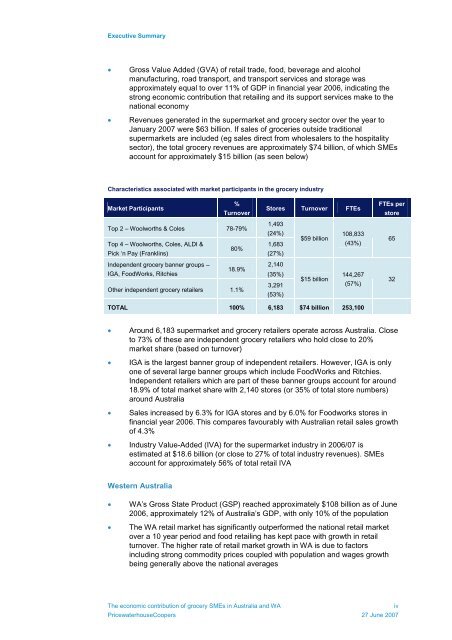The economic contribution of small to medium-sized grocery ...
The economic contribution of small to medium-sized grocery ...
The economic contribution of small to medium-sized grocery ...
Create successful ePaper yourself
Turn your PDF publications into a flip-book with our unique Google optimized e-Paper software.
Executive Summary<br />
<br />
<br />
Gross Value Added (GVA) <strong>of</strong> retail trade, food, beverage and alcohol<br />
manufacturing, road transport, and transport services and s<strong>to</strong>rage was<br />
approximately equal <strong>to</strong> over 11% <strong>of</strong> GDP in financial year 2006, indicating the<br />
strong <strong>economic</strong> <strong>contribution</strong> that retailing and its support services make <strong>to</strong> the<br />
national economy<br />
Revenues generated in the supermarket and <strong>grocery</strong> sec<strong>to</strong>r over the year <strong>to</strong><br />
January 2007 were $63 billion. If sales <strong>of</strong> groceries outside traditional<br />
supermarkets are included (eg sales direct from wholesalers <strong>to</strong> the hospitality<br />
sec<strong>to</strong>r), the <strong>to</strong>tal <strong>grocery</strong> revenues are approximately $74 billion, <strong>of</strong> which SMEs<br />
account for approximately $15 billion (as seen below)<br />
Characteristics associated with market participants in the <strong>grocery</strong> industry<br />
Market Participants<br />
%<br />
Turnover<br />
Top 2 – Woolworths & Coles 78-79%<br />
Top 4 – Woolworths, Coles, ALDI &<br />
Pick ‘n Pay (Franklins)<br />
80%<br />
Independent <strong>grocery</strong> banner groups –<br />
IGA, FoodWorks, Ritchies<br />
18.9%<br />
Other independent <strong>grocery</strong> retailers 1.1%<br />
S<strong>to</strong>res Turnover FTEs<br />
1,493<br />
(24%)<br />
108,833<br />
$59 billion<br />
1,683<br />
(43%)<br />
(27%)<br />
2,140<br />
(35%)<br />
144,267<br />
$15 billion<br />
3,291<br />
(57%)<br />
(53%)<br />
FTEs per<br />
s<strong>to</strong>re<br />
65<br />
32<br />
TOTAL 100% 6,183 $74 billion 253,100<br />
<br />
<br />
<br />
<br />
Around 6,183 supermarket and <strong>grocery</strong> retailers operate across Australia. Close<br />
<strong>to</strong> 73% <strong>of</strong> these are independent <strong>grocery</strong> retailers who hold close <strong>to</strong> 20%<br />
market share (based on turnover)<br />
IGA is the largest banner group <strong>of</strong> independent retailers. However, IGA is only<br />
one <strong>of</strong> several large banner groups which include FoodWorks and Ritchies.<br />
Independent retailers which are part <strong>of</strong> these banner groups account for around<br />
18.9% <strong>of</strong> <strong>to</strong>tal market share with 2,140 s<strong>to</strong>res (or 35% <strong>of</strong> <strong>to</strong>tal s<strong>to</strong>re numbers)<br />
around Australia<br />
Sales increased by 6.3% for IGA s<strong>to</strong>res and by 6.0% for Foodworks s<strong>to</strong>res in<br />
financial year 2006. This compares favourably with Australian retail sales growth<br />
<strong>of</strong> 4.3%<br />
Industry Value-Added (IVA) for the supermarket industry in 2006/07 is<br />
estimated at $18.6 billion (or close <strong>to</strong> 27% <strong>of</strong> <strong>to</strong>tal industry revenues). SMEs<br />
account for approximately 56% <strong>of</strong> <strong>to</strong>tal retail IVA<br />
Western Australia<br />
<br />
<br />
WA’s Gross State Product (GSP) reached approximately $108 billion as <strong>of</strong> June<br />
2006, approximately 12% <strong>of</strong> Australia’s GDP, with only 10% <strong>of</strong> the population<br />
<strong>The</strong> WA retail market has significantly outperformed the national retail market<br />
over a 10 year period and food retailing has kept pace with growth in retail<br />
turnover. <strong>The</strong> higher rate <strong>of</strong> retail market growth in WA is due <strong>to</strong> fac<strong>to</strong>rs<br />
including strong commodity prices coupled with population and wages growth<br />
being generally above the national averages<br />
<strong>The</strong> <strong>economic</strong> <strong>contribution</strong> <strong>of</strong> <strong>grocery</strong> SMEs in Australia and WA<br />
PricewaterhouseCoopers 27 June 2007<br />
iv

















